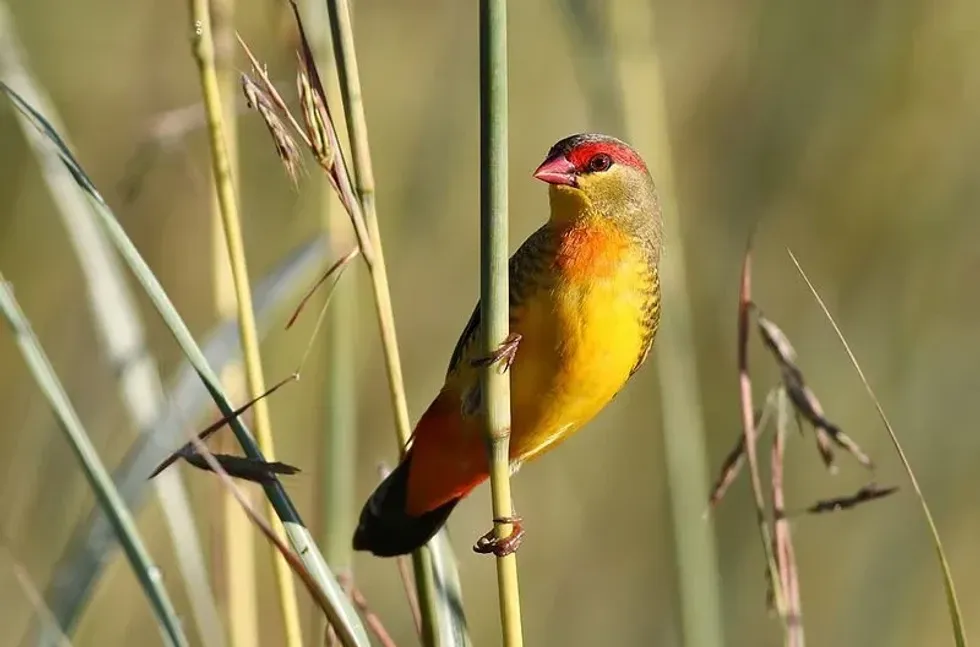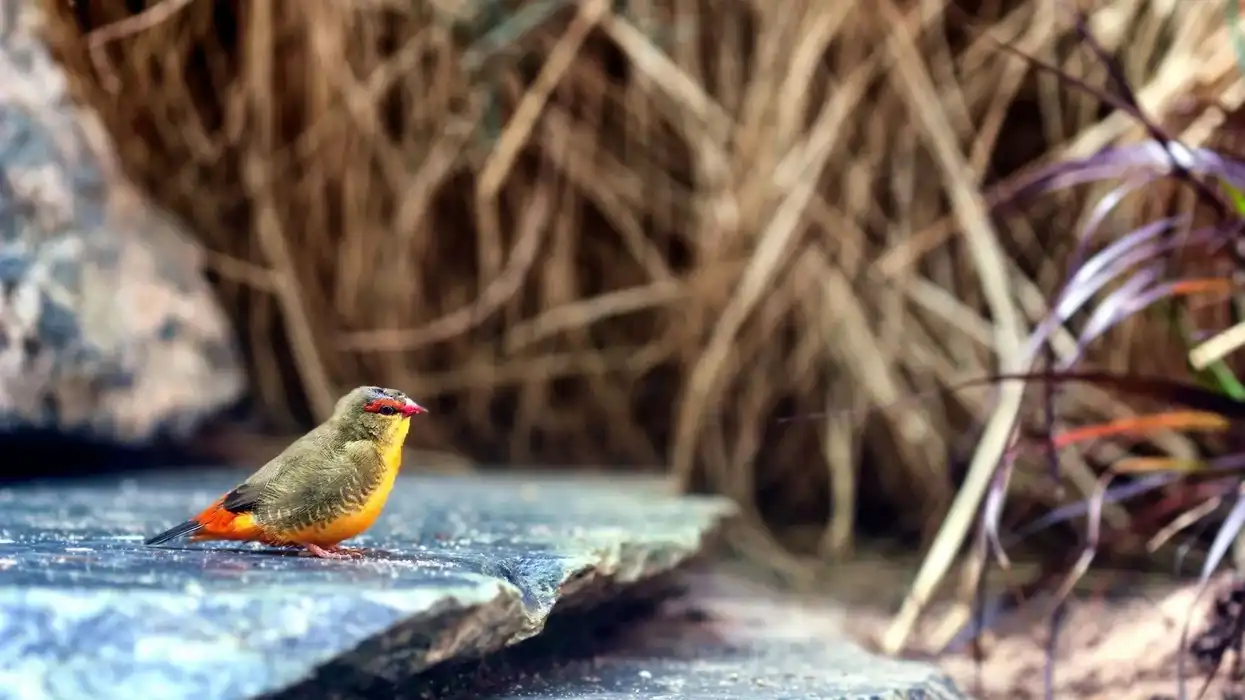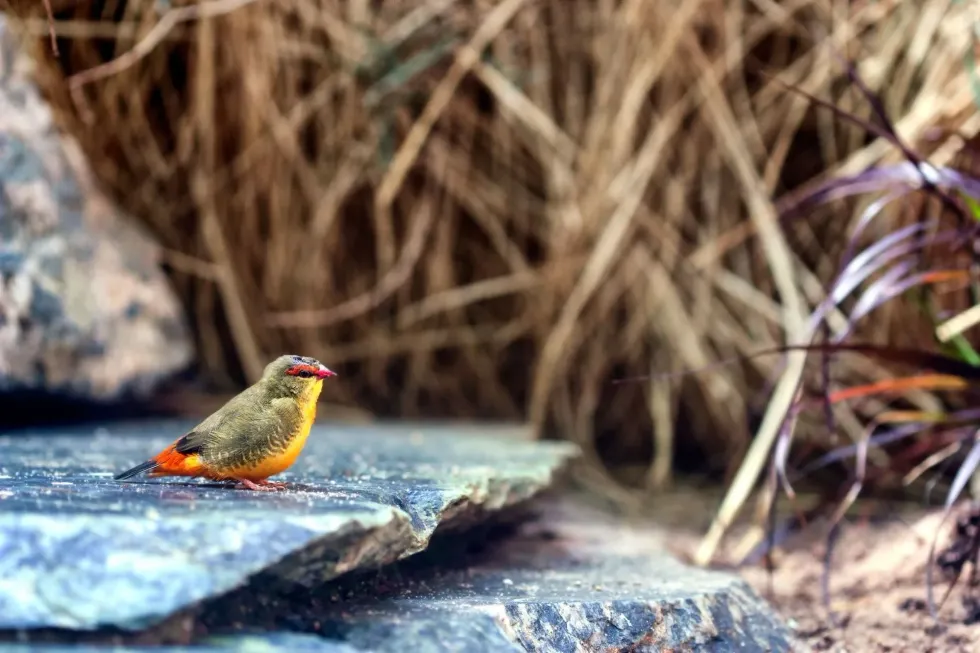Fun Gold-breasted Waxbill Facts For Kids

The gold-breasted waxbill (Amandava subflava; synonym- Sporaeginthus subflavus) is a waxbill species also known as orange-breasted waxbills or the Zebra waxbills. These finches are sparrow-like and are native to sub-Saharan Africa, inhabiting the southern savannah and grassland of the Sahara. These species were introduced into Kuwait and Saudi Arabia.
Though this finch from Africa looks tiny, colorful, and fragile, it is the easiest species to breed but they tend to become territorial during the breeding seasons.
Unlike our pet birds, these waxbills do not like to be handled by their owners every day, so it is suggested that you should keep your hands away from them while in captivity.
Although it is common in many birds to become accustomed to humans, these birds never get comfortable enough to perch on the human housemate's finger.
These birds are very peaceful, active, and ideal birds for a mixed collection in an aviary. Their diet mostly consists of grass seeds, grass stems, and small invertebrates.
There are two recognized subspecies of the gold-breasted waxbill known as the Amandava subflava clarkei and Amandava subflava subflava. These birds forage mostly on the ground under the grasses of the grassland and savannah. They are born with a black bill which turns into flaming red as they grow up.
If you like these true facts about gold-breasted waxbill, then you'll surely like these facts about lavender waxbill and common waxbill too!
Gold-Breasted Waxbill Interesting Facts
What type of animal is a gold-breasted waxbill?
The gold-breasted waxbill (Amandava subflava) is the smallest member of the Estrildidae finch family and is a close relative to the Strawberry finches.
What class of animal does a gold-breasted waxbill belong to?
As is common with most species of birds, the gold-breasted waxbill (Amandava subflava) also belongs to the Aves class.
How many gold-breasted waxbills are there in the world?
The global population size of the gold-breasted waxbill (Amandava subflava) has not been evaluated to the exact number. This finch species is seasonally and locally common in its natural habitat which helps in deducing that its population is large.
Where does a gold-breasted waxbill live?
The orange-breasted waxbill ranges are found in the savannahs and grassland of their large habitat range from the south of the Sahara in Africa throughout Kenya, Sudan, Ethiopia, Angola, Botswana, and Namibia. These finches build their nest near the swamps with wet grasses, marshes, and streams but for feeding areas, these species prefer open and dry areas.
What is a gold-breasted waxbill's habitat?
The gold-breasted waxbills in the northern part of their habitat build nest among reeds, grass stalks, and small bushes by using fine grasses forming a circular nest with a tube-shaped side entrance.
Whereas, the gold-breasted waxbill from southern parts of the habitat prefers to acquire the abandoned domed-shaped nests of other species, which they simply tidy up by making a new lining.
Cock and hen both use feathers to line their nests. Very often these birds are found in the flooded areas along rivers.
Who do gold-breasted waxbills live with?
During the off-season, the orange-breasted waxbill lives together in large groups but during breeding season males become territorial and spend time only with their partners.
How long does a gold-breasted waxbill live?
The average lifespan of the orange-breasted waxbill is between 8-11 years in the wild, which can be extended by up to 15 years by providing proper care and diet in captivity.
How do they reproduce?
Both the male and female orange-breasted waxbill or Zebra waxbill reach their sexual maturity by the age of one year old, the suitable age for these birds to breed is between the age of one to four years old.
The breeding season starts from the rainy season extending up to the beginning of the dry season in the wild, whereas, in captivity, breeding can be simulated throughout the year by providing the right climatic condition.
During the breeding season, males tend to fight with each other to keep them away from their courting areas. Cock hops and bows with its tail angled around the hen, and once the females decide to accept the offer from the male to mate, they start crouching and quivering their tails.
In captivity female golden-breasted waxbills mix with other species and sometimes engage in inter-species allopreening.
Females lay three to six eggs in a single clutch, and incubation is done by both the parents. Young waxbills after hatching take 17-21 days for fledging and two months for their first molt, once these young waxbills are able to fend themselves they leave their parents' nest and build their own.
What is their conservation status?
The population trend of the Zebra waxbill appears to be stable, and hence these finches are listed as a species of Least Concern on the IUCN Red List. Though the population size of this species has not been quantified, these birds are common in their natural habitat.
Gold Breasted Waxbill Fun Facts
What do gold-breasted waxbills look like?
The golden-breasted waxbills are small-sized birds, with olive color wings and backs. These birds have a red beak, red-orange irides with a bright yellow underbody, and olive flanks with buff-yellow bars and red rumps. These birds have pale brown legs and black tails. Most of the males have a red stripe on top of their eyes.
The northern subspecies of orange-breasted waxbills have blazing orange color on the belly and breast whereas, the southern subspecies have orange patches on the center of their breast but lack such blazing yellow color compared to the northern subspecies.
It is very simple to differentiate males and females of this species as the females are duller and do not have the red stripe on top of their eyes.

How cute are they?
The small size and vibrant yellow color breast make these birds extremely cute and mesmerizing to look at.
How do they communicate?
A series of high-pitched monotonous chirps are used by these birds to communicate with each other. Male waxbill usually sings in the morning before dawn and after dusk.
How big is a gold-breasted waxbill?
The orange-breasted waxbill is a small-sized bird that can extend up to 3.5-4 in (8.9-10.1 cm) in wingspan, and since these birds are sexually dimorphic, the males are larger than females. These birds are of the same size as a Lesser Goldfinch and half the size of the Red finch and House finch.
How fast can a gold-breasted waxbill fly?
The accurate speed of these finch family birds cannot be stated due to the lack of specific data.
How much does a gold-breasted waxbill weigh?
A golden-breasted waxbill is one of the smallest birds in the finch family and is extremely light, weighing only up to 0.17-0.28 oz (5-8 g) which is lighter than the Gouldian finch.
What are the male and female names of the species?
A male gold-breasted waxbill is called a cock and the female is called a hen.
What would you call a baby gold-breasted waxbill?
A young gold-breasted waxbill is called a chick. These young chicks have a duller appearance with buff-brown upper body and dull buff underparts and wash of yellow on the center of their breast with brown eyes and black bill.
What do they eat?
Gold-breasted waxbills are omnivores in nature and their food comprises seeds and insects. This bird prefers soaked millets grains, green food, green seeds, and small live food such as ant pupae, mealworms, termites, and other small insects.
In the wild, these birds forage mostly on the ground, feeding on small invertebrates, grass stems, and grass seeds spending most of their time on the ground even when they are not searching for food.
In captivity, these birds should be provided with a proper breeding diet one month prior to the breeding which should consist of finch mix food that is easily available on the market.
Are they dangerous?
No, these waxbills are not dangerous at all. They are docile but become territorial and fight with other males during the breeding season.
Would they make a good pet?
Yes, the gold-breasted waxbills will make a wonderful pet as they are sociable, friendly, and active birds. Despite their small size, these birds should not be kept in a small cage as they are very active and need space to fly and hop around.
Newly purchased birds take time to behaviorally change in an environmental factor under controlled conditions such as heated enclosures and extended lights for long winters in their cage. The cage should also contain vertical perching such as bamboo or small ladders to climb which these birds appreciate.
These species can also thrive in a mixed aviary with other species if provided plenty of covers to reduce minor quarrels among them.
If the newly hatched young chicks are provided a diet that lacks vitamin A and D, these young birds may start developing dark plumage known as induced melanism which gets corrected as they grow up. In captivity, frequent nail trimming is required for this finch as its claw tends to overgrow.
Females become egg-bound during the cold weather, so providing adequate heat is necessary for both the parents for breeding.
Did you know...
Gold-breasted waxbills have been found hybridizing with many other species such as Green Avadavat, Red Avadavat, Red-billed Fire finch, Red-cheeked Cordon Bleu, Common waxbill, African silverbill, and black-rumped waxbill.
The young waxbill crouches and twists its neck while opening its black bill and flutters the wing to beg for food from its parents.
It is very easy to determine the sex of these birds visually as the male bird has a lot brighter plumage compared to the female who is duller in shade.
For successful breeding in captivity, the best option is to provide these birds with a well-planted aviary with numerous nests available to choose from such as wooden finch nest boxes, wicker nest, and many other types of nest.
Clarke’s waxbill (Amadava subflava clarkii) is a more colorful and larger subspecies that inhabits the southern habitat range of the Zebra waxbill.
Though the Zebra waxbills are hardy birds, they cannot tolerate cold or extended damp temperatures, these birds do well at 55-60 °F (12.7-15.5 °C).
Some gold-breast waxbills can be very dexterous parents and good sitters and yet few of these birds can be completely impartial to their young chicks without any obvious reasons.
Do gold-breasted waxbills migrate?
Gold-breasted waxbills do not migrate, as they have a vast distribution of habitat range extending all the way from the south of sub-Saharan regions of Africa. These animals are not endemic.
How many eggs do gold-breasted waxbill lay?
The average clutch size of the gold-breasted waxbill is three to six eggs with an incubation period of 11-14 days. Once the female lays her third and fourth egg both parents start incubating the eggs simultaneously.
Here at Kidadl, we have carefully created lots of interesting family-friendly animal facts for everyone to discover! Learn more about some other birds from our Southern Cassowary fun facts and Shoebill interesting facts for kids pages.
You can even occupy yourself at home by coloring in one of our free printable four calling birds coloring pages.
Second image by Derek Keats.
We Want Your Photos!
More for You
See All
Bachelor of Arts specializing in Journalism and Mass Communication, Postgraduate Diploma in Sports Management

Moumita DuttaBachelor of Arts specializing in Journalism and Mass Communication, Postgraduate Diploma in Sports Management
A content writer and editor with a passion for sports, Moumita has honed her skills in producing compelling match reports and stories about sporting heroes. She holds a degree in Journalism and Mass Communication from the Indian Institute of Social Welfare and Business Management, Calcutta University, alongside a postgraduate diploma in Sports Management.
Bachelor of Arts specializing in Economics

Gowri RaoBachelor of Arts specializing in Economics
With a bachelor's degree in Economics from Krea University, Gowri is a highly skilled data analyst and an expert in regression and causation modeling. Her interests in economic trends, finance, and investment research complement her professional expertise. In addition to her professional pursuits, Gowri enjoys swimming, running, and playing the drums, and she is also a talented tutor.
Disclaimer
1) Kidadl is independent and to make our service free to you the reader we are supported by advertising. We hope you love our recommendations for products and services! What we suggest is selected independently by the Kidadl team. If you purchase using the Buy Now button we may earn a small commission. This does not influence our choices. Prices are correct and items are available at the time the article was published but we cannot guarantee that on the time of reading. Please note that Kidadl is a participant in the Amazon Services LLC Associates Program, an affiliate advertising program designed to provide a means for sites to earn advertising fees by advertising and linking to Amazon. We also link to other websites, but are not responsible for their content.
2) At Kidadl, we strive to recommend the very best activities and events. We will always aim to give you accurate information at the date of publication - however, information does change, so it’s important you do your own research, double-check and make the decision that is right for your family. We recognise that not all activities and ideas are appropriate for all children and families or in all circumstances. Our recommended activities are based on age but these are a guide. We recommend that these ideas are used as inspiration, that ideas are undertaken with appropriate adult supervision, and that each adult uses their own discretion and knowledge of their children to consider the safety and suitability. Kidadl cannot accept liability for the execution of these ideas, and parental supervision is advised at all times, as safety is paramount. Anyone using the information provided by Kidadl does so at their own risk and we can not accept liability if things go wrong.
3) Because we are an educational resource, we have quotes and facts about a range of historical and modern figures. We do not endorse the actions of or rhetoric of all the people included in these collections, but we think they are important for growing minds to learn about under the guidance of parents or guardians.







